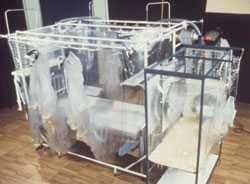Infection Control: Hospital
There are few scientific studies pertaining to the transmission of monkeypox virus and most were conducted in Africa. Person-to-person transmission of monkeypox virus is believed to occur by the same mechanisms exploited by variola virus during the smallpox era, namely via respiratory droplets or by direct contact with lesion material.
Precautions to Prevent Monkeypox Transmission
A combination of standard, contact, and droplet precautions [PDF – 226 pages] should be applied in all healthcare settings when a patient presents with fever and vesicular/pustular rash.
In addition, because of the theoretical risk of airborne transmission of monkeypox virus, airborne precautions should be applied whenever possible.If a patient presenting for care at a hospital or other health care facility is suspected of having monkeypox, infection control personnel should be notified immediately.
Isolation

Isolate patients suspected of having monkeypox in a negative air pressure room as soon as possible.
Isolate patients suspected of having monkeypox in a negative air pressure room as soon as possible. If a negative air pressure room is unavailable, place patients in a private examination room. If neither option is feasible, then precautions should be taken to minimize exposure to surrounding persons. These precautions may include placing a surgical mask over the patient’s nose and mouth—if tolerable to the patient—and covering any of the patient’s exposed skin lesions with a sheet or gown.
Personal Protective Equipment (PPE)
Personal protective equipment should be donned before entering the patient’s room and used for all patient contact. All PPE should be disposed of prior to leaving the isolation room where the patient is admitted.
Optimal personal protective measures include:
- Use of disposable gown and gloves for patient contact.
- Use of NIOSH-certified N95 (or comparable) filtering disposable respirator that has been fit-tested for the healthcare worker using it, especially for extended contact in the inpatient setting.
- Visit The National Personal Protective Technology Laboratory (NPPTL) for frequently asked questions and answers about wearing respirators versus surgical masks.
- Use of eye protection (e.g., face shields or goggles), as recommended under standard precautions, if medical procedures may lead to splashing or spraying of a patient’s body fluids.
Additional Precautions
In addition to isolating infectious patients and use of PPE when caring for patients, other standard precautions can limit the transmission of monkeypox virus.
These include:
- Proper hand hygiene after all contact with an infected patient and/or their environment during care.
- Correct containment and disposal of contaminated waste (e.g., dressings) in accordance with facility-specific guidelines for infectious waste or local regulations pertaining to household waste.
- Care when handling soiled laundry (e.g., bedding, towels, personal clothing) to avoid contact with lesion material.
- Soiled laundry should never be shaken or handled in manner that may disperse infectious particles.
- Care when handling used patient-care equipment in a manner that prevents contamination of skin and clothing.
- Ensure that used equipment has been cleaned and reprocessed appropriately.
- Ensure procedures are in place for cleaning and disinfecting environmental surfaces in the patient care environment.
- Any EPA-registered hospital disinfectant currently used by healthcare facilities for environmental sanitation may be used. Follow the manufacturer’s recommendations for concentration, contact time, and care in handling.
More detailed respirator information has been published by NIOSH and OSHA.
Personal Protective Equipment Resources
- Page last reviewed: May 11, 2015
- Page last updated: May 11, 2015
- Content Source:


 ShareCompartir
ShareCompartir